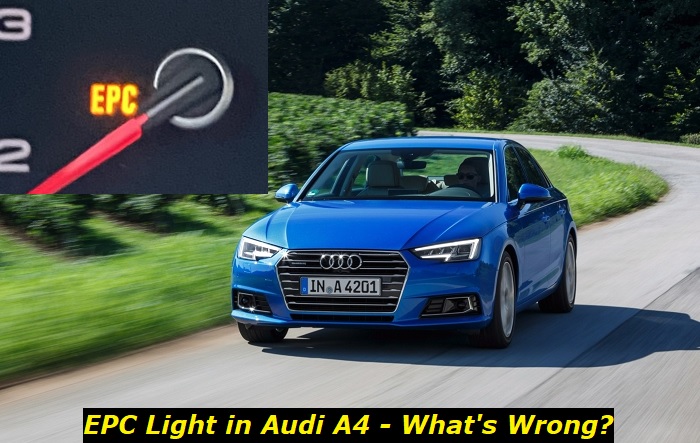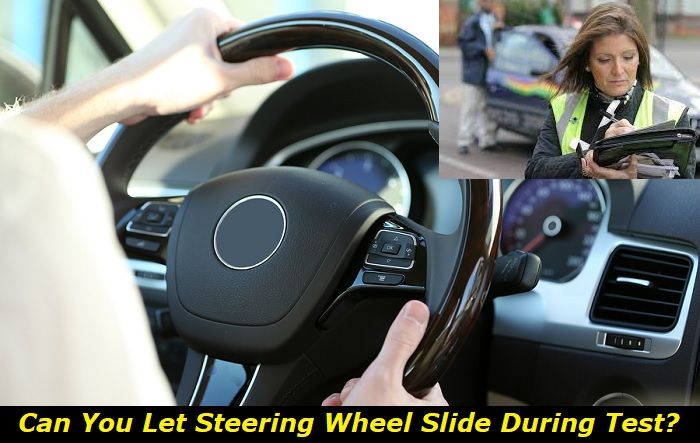The Audi A4 is a front-engine car, that is available as a front-wheel drive or "Quattro" all-wheel drive version. You can also have it with a sedan or a station wagon body type (in Europe). The A4 is manufactured in Audi's German car factory. Audi is among the favorite brands of the Volkswagen Auto Group, which is getting bigger and bigger each year and is known for making some great cars.
EPC light highlights
- Common reasons:electronic throttle problems, throttle sensor issues
- How to fix:check the sensors, check the throttle, use the scanner
- Possible consequences:broken throttle may leave you stranded or send the car to the limp mode
- Priority level:Medium
- Can you drive?Yes
- DIY repair:Possible but complicated
- Repair price range:$50-$500

Why Is The EPC Light On - What Is It?
The EPC light on an Audi A4 is on to warn you as a driver that there is a problem with your vehicle's electronic power control (EPC) system or a PCM (powertrain control module) problem on your Audi A4.
The issue usually comes from the car's throttle system, and somehow, it is a safety precaution as well. But a bad throttle body, bad Ignition coil, bad spark plug, or faulty or clogged injectors can also trigger the EPC light, and cause your Audi A4 to shake while driving. This might be scary when you don't know what is going on.
EPC stands for Electronic Power Control, to make this easier for you to understand, I'll say that this light is very similar to the Check Engine light. But don't let that fool you, because the Check Engine light can also be found in Audi and other Volkswagen cars. Some manufacturers use the term Electronic Throttle Control (ETC) which has the same function as the EPC light, some others have the Malfunction Indicator Lamp (MIL), but they all serve the same purpose, and that is to warn you as a driver of a fault found in the car.
The ECU (Engine Control Unit), transmission control unit, steering control unit, and brake control unit monitor the EPC system.
Depending on where the problem is, the EPC light might show up together with the ESP (Electronic Stability Program), ABS, or Engine light.
Problems that cause this light to illuminate are plenty, and of different natures, but I will try to select some of the main causes in this article.
We mentioned the throttle system, which includes the accelerator pedal, and even the throttle body. Other problems that cause the EPC light to illuminate might be, fuel injection, ABS or other brake issues, wiring issues, or other electrical issues. Today's cars are having much more electronics and sensors for controlling a lot of car's functions, so, many sensors can cause the EPC light to turn on as well. Air sensors, ABS or brake pressure sensors, and steering angle sensors can all trigger the EPC light.
Some other engine sensors that can trigger the EPC light are the MAF (Mass Air Flow) sensor, IAT (Intake Air Temperature) sensor, ECT (Engine Coolant Temperature) sensor, and O2 sensor. An Internal engine problem, or even with the engine itself, will also light up the EPC. Malfunctions in the fuel metering or emissions systems and issues with the traction control, vehicle stability control, or cruise control can activate the EPC light too.
Symptoms of Problems with EPC Warning Light
When the EPC warning light is on, depending on the problem that caused it to illuminate, the ECU (Electronic Computer Unit) can limit your car's RPM and car's pulling power, or even gears in some Automatic transmission A4 models, as it considers that the engine can still operate but not at all rpm levels and/or gears, this is also known as Limp Mode or Limp Home Mode, and it is there to preserve further engine damage or harm.
As I said earlier the EPC light is connected to numerous other systems and works in conjunction with all of them, as a result, a few other warning lights might also appear on the dashboard. Since the engine is not fully functional, the 'Check Engine Light is the first and most likely to appear.
In addition, the ECU can turn the stability control and cruise control systems off, causing their corresponding dashboard warning lights to light up. Other warnings may include the steering wheel and ABS.
How Do You Fix or Reset The EPC Warning Light?
You can just reset the EPC light in some Audi A4 models but I recommend you not to do that until the issue that is causing the EPC light to illuminate in the first place has been identified and fixed. By resetting the EPC warning light without addressing the actual fault, you will not resolve the issue causing the light to turn on.
Moreover, if there is a genuine issue with your vehicle's engine or electronic control system, and you continue to drive without addressing it properly you are risking further damage to your car, reduced fuel efficiency, and even compromised safety. So, it is critical to have the vehicle inspected by a qualified mechanic to diagnose and fix the root cause of the problem first.
In some cases, the EPC light may even temporarily go off after a reset, but it will likely turn back on as the system might detect the problem again.
The easiest way to find out the exact cause of why the EPC light turned on is to have the problem code read by an OBD scanner. You can do this yourself or you can take your Audi to a qualified mechanic who will do it for you. Otherwise, you might have to go through all the possible causes that I mentioned earlier to find the fault without an OBD scanner. The OBD scanners are much cheaper today, and they are quite straightforward to use, you can search Google for what the trouble codes mean easily too.
The scanning process will give you clues on what is causing the EPC light to turn on, and/or the car to shake and lose power.
For instance, if you get codes for cylinder misfiring, ignition coils or spark plugs could be the culprits, or if you get fuel-related codes then chances are that your injectors are causing the EPC light to illuminate.
The point is when you get the codes, you will know what needs to be fixed for the EPC light and the car shaking to go away. If it's a simple fix like a bad spark plug or a vacuum leak, you can probably fix it yourself, but if something more complicated happens to be the case, I recommend you take the car to an Audi dealer or an independent mechanic to do the job.
If the EPC light shows up while driving - Tips
Is It safe to drive the car with the EPC light on? The quick answer is no. As mentioned earlier, the EPC light could indicate a wide range of problems, some minor and some more serious.
So, if you are driving the car and it suddenly starts showing signs like illuminated EPC light, starts shaking, and goes on limp mode, you need to take it to a dealer or a mechanic for OBD diagnosis and repair as soon as you can. You can still drive it, but only so you don't have to tow it, and not for long trips, as the engine can suffer serious harm.
Otherwise, if it happens on the road, you can do the following:
- First thing I would advise you is to pull over somewhere safely, as I said earlier, the EPC light can turn on as a result of an issue with the engine, so it's best to turn off the engine to prevent further damage if possible.
- You can try restarting the engine later and see if the EPC light comes on again. Sometimes, only a temporary glitch in the system can turn the EPC light on. Today's cars have advanced onboard diagnostic systems, and sometimes they can reset small glitches like that.
- Check out for other warning lights that may be lit on the dashboard. This can be useful for you to diagnose what might have caused the EPC light to turn on.
- Inspect the vehicle for visible issues, for example, check the engine bay, and look for any loose or disconnected wires, damaged hoses, or fluid leaks. But be cautious, and avoid touching hot and moving parts of the engine.
- Lastly, ask for assistance from a qualified mechanic. If the EPC light remains on, it is best to have the vehicle diagnosed by a qualified mechanic at the authorized service center itself. They will be able to diagnose the specific problem and recommend the necessary steps you should take.
About the authors
The CarAraC research team is composed of seasoned auto mechanics and automotive industry professionals, including individuals with advanced degrees and certifications in their field. Our team members boast prestigious credentials, reflecting their extensive knowledge and skills. These qualifications include: IMI: Institute of the Motor Industry, ASE-Certified Master Automobile Technicians; Coventry University, Graduate of MA in Automotive Journalism; Politecnico di Torino, Italy, MS Automotive Engineering; Ss. Cyril and Methodius University in Skopje, Mechanical University in Skopje; TOC Automotive College; DHA Suffa University, Department of Mechanical Engineering






Add comment